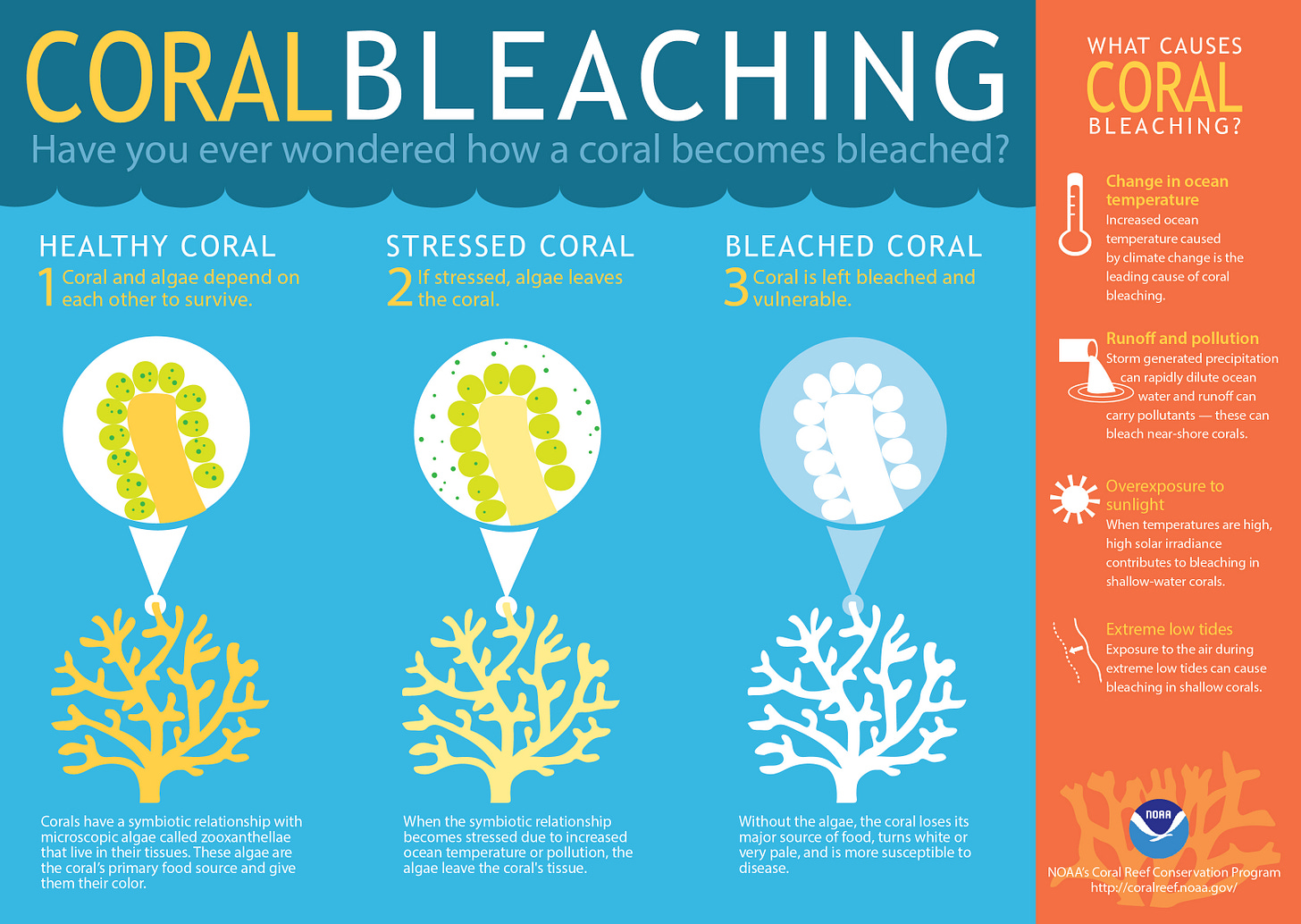Sunny climate stormy climate | Weekly digest #66
India has drafted emission intensity targets for industry, we have a new conservation reserve in Spiti valley and the largest coral bleaching event in history is ongoing
Hello folks!
Welcome to another edition of your regular climate news digest, where I bring two sunny stories that gives hope and one stormy one that is a cause for alarm. Hope you like them!
🌞 Sunny news 🌞
1. India has drafted emission standards for industry, but power sector is missing from the list
What are we talking about?
The Indian government has drafted mandatory emissions intensity targets for high-emitting industries. If industrial units do not meet these, a fine will be levied by the Central Pollution Control Board.
Units that reduce emissions beyond the given target can generate credits and sell them in the carbon market. Units that struggle to meet their targets can purchase these credits to meet their goals.
As it stands, 282 industrial units are obligated to meet these new targets, spanning the aluminium, cement, chlor-alkali, and pulp and paper sectors. The government also plans on including the fertiliser, iron, steel, petrochemicals and petroleum refinery sectors at a later stage.
However, the power sector responsible for 39.2% of carbon emissions, is excluded from the list of obligated industries.
Why does this matter?
Emissions intensity refers to carbon dioxide emitted per unit of economic output or activity.
The draft notification has created, for the first time, baseline emissions for each industrial unit covered, with targets set over two compliance years (2025-2026 and 2026-2027).
In August 2022, the Indian government pledged to reduce its greenhouse gas emissions intensity by 45% by 2030, compared to 2005 levels. India has also pledged to reach net-zero emissions by 2070 and is rapidly scaling up renewable sources. These guidelines will play a key role in helping India meet these targets.
Sources for further reading
Also, please check out our latest video on Mumbai’s coastal road!
2. India’s largest conservation reserve comes up in Spiti Valley
What are we talking about?
The Himachal Pradesh state government notified the Tsarap Chu Conservation Reserve, spread over 1,585 square kilometres in Spiti valley by issuing a notification on May 7, 2025.
Tsarap Chu joins Darlaghat, Naina Devi, Potter Hill, and Shilli as Himachal Pradesh’s fifth conservation reserve.
The Reserve will be managed through a Conservation Reserve Management Committee, which will also include representatives from local Panchayats. The committee will manage the area while balancing the needs of local communities and wildlife conservation priorities.
Why does this matter?
Its geographical spread makes Tsarap Chu extremely important from the point of view of biodiversity and ecology.
It is one of select areas in Himachal Pradesh with a high density of snow leopards. This area is also the catchment area of the Charap Nala and is an important wildlife corridor connecting the Kibber and Chandratal sanctuaries, which is extremely important for biodiversity.
Apart from the snow leopard, Tibetan wolf, bharal (blue sheep), Himalayan ibex, kiang (wild ass), and the Tibetan argali are also found in the region. Rare bird species such as Rose Finch, Tibetan Raven, and Yellow-billed Chough enrich the ecology of the region.
Sources for further reading
🌩️ Stormy news 🌩️
3. The largest coral bleaching event in history is ongoing - affecting 84% of the worlds corals!
What are we talking about?
The world’s coral reefs are undergoing a mass coral bleaching event that began in 2023, is still ongoing and became the largest event ever recorded.
What is coral bleaching? - When corals are stressed by changes in conditions such as temperature, light, or nutrients, they expel the symbiotic algae living in their tissues, causing them to turn completely white. This is called coral bleaching.
Some 83.7% of the world’s coral reef area across at least 83 countries and territories have been impacted by bleaching-level heat stress since January 2023, the US National Oceanic and Atmospheric Administration (NOAA) announced last week.
It is the fourth mass coral bleaching event ever recorded and the second to occur in the last 10 years.
Why does this matter?
Coral reefs are extremely important ecosystems that exist in more than 100 countries and territories and support at least 25% of marine species; they are integral to sustaining Earth’s vast and interconnected web of marine biodiversity and provide ecosystem services valued up to $9.9 trillion annually. They are sometimes referred to as “rainforests of the sea” for their ability to act as carbon sinks by absorbing the excess carbon dioxide in the water.
Mass bleaching events like this one are causing these critical ecosystems to disappear at an alarming rate.
Sources for further reading
You can read previous editions of the newsletter -
Sunny climate, stormy climate | News Digest #65
Sunny climate, stormy climate | News Digest #64
Sunny climate, stormy climate | News Digest #63
If you liked this newsletter, please hit like or leave a comment. If you are a climate champion and want to take this conversation to more people, please share the newsletter with a friend, family member or colleague who may like it too!





